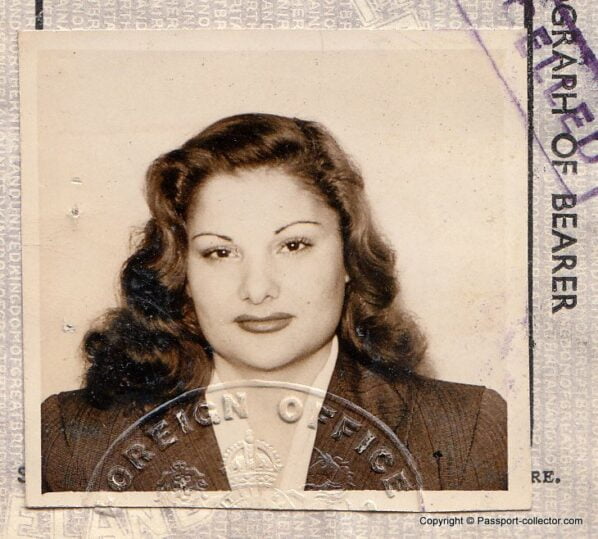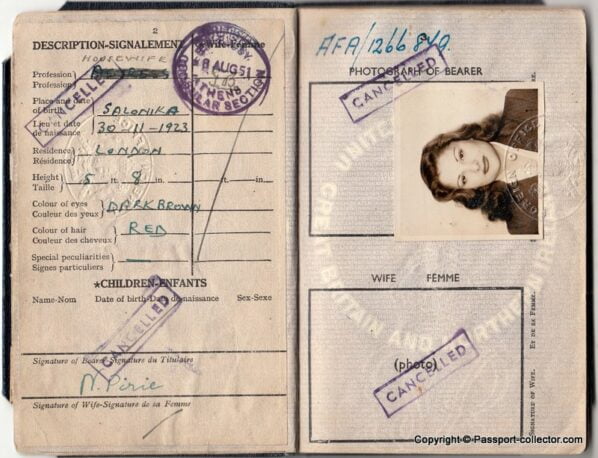British Passport, Secret Service Agent’s Wife
Major Ian Pirie was a British agent working for the Secret Service – SOE. Major Pirie was stationed in Crete and Niki Dermetzi, a devastating blonde at the Argentina nightclub, was his girlfriend and later his wife. Niki’s British passport was issued in 1947 in London with numerous revenues: 7 Greek, 1 British, 2 Turkish & 3 Spanish, and many border stamps. (SOE activities in Greece, 1940-1942)

The Germans expected their airborne attack on Crete in 1941 – a unique event in the history of warfare – to be a textbook victory based on tactical surprise. They had no idea that the British, using Ultra intercepts, knew their plans and had laid a carefully planned trap. It should have been the first German defeat of the war, but a fatal misunderstanding turned the battle round.
Nor did the conflict end there. Ferocious Cretan freedom fighters mounted a heroic resistance, aided by a dramatic cast of British officers from Special Operations Executive. British Passport Secret Service
They were among the last to leave Athens – only a few hours before the Germans raised their flag over the Acropolis – Nicholas Hammond, David Pawson, Ian Pirie, and Nicki Demertzi. To ensure Nicki’s safe conduct in the face of British officialdom, the couple had hurriedly married. Leaving Athens at dawn, they drove to the yacht harbor of Tourkolimano. Their load included a large batch of German uniforms, which Pirie had been hoarding, and the remains of Hammond’s plastic explosive (Source: Antony Beevor – Crete – The Battle and the Resistance, 1991, ISBN 978-1-84854-635-6). British Passport Secret Service

The Special Operations Executive (SOE)
was a British World War II organization. Following Cabinet’s approval, it was officially formed by Minister of Economic Warfare Hugh Dalton on 22 July 1940 to conduct espionage, sabotage, and reconnaissance in occupied Europe against the Axis powers and aid local resistance movements.
It was initially also involved in forming the Auxiliary Units, a top-secret “stay-behind” resistance organization that would have been activated in the event of a German invasion of Britain.
Few people were aware of SOE’s existence
It was sometimes referred to as “the Baker Street Irregulars,” after the location of its London headquarters, to those who were part of it or liaised with it. It was also known as “Churchill’s Secret Army” or the “Ministry of Ungentlemanly Warfare.”
To enhance security, names like the “Joint Technical Board” or “Inter-Service Research Bureau” concealed various branches or the entire organization. Fictitious branches of the Air Ministry, Admiralty, or War Office were also used.
SOE operated in all countries or former countries occupied by or attacked by the Axis forces, except where demarcation lines were agreed with Britain’s principal Allies (the Soviet Union and the United States). It also made use of neutral territory occasionally or made plans and preparations if the Axis attacked neutral countries.
The organization directly employed or controlled just over 13,000 people, about 3,200 of whom were women. It is estimated that SOE supported or supplied approximately 1,000,000 operatives worldwide. British Passport Secret Service

Operations in Greece
The Axis overran Greece after a desperate defense lasting several months. In the aftermath, SIS and another intelligence organization, SIME, discouraged attempts at sabotage or resistance as this might imperil relations with Turkey. However, SOE maintained contact with resistance groups in Crete.
When agent “Odysseus,” a former tobacco-smuggler, tried to contact potential resistance groups in Greece, he reported that no group would cooperate with the monarchist government in exile in Cairo.
Operation Harling
In late 1942, the army instigated SOE’s first operation, Operation Harling, to disrupt the railway in Greece. Colonel Eddie Myers, later Brigadier, with assistance from Christopher Woodhouse, parachuted into Greece. They discovered two guerrilla groups in the mountains: the pro-Communist ELAS and the republican EDES.
On 25 November 1942, Myers’s party blew up one of the railway viaduct’s spans at Gorgopotamos, supported by 150 Greek partisans from these two organizations that engaged Italians guarding the viaduct. This cut the railway linking Thessaloniki with Athens and Piraeus. British Passport Secret Service
Operation Husky
Relations between the resistance groups and the British soured. When the British needed to disrupt the railway across Greece as part of the deception operations preceding Operation Husky, the Allied invasion of Sicily, the resistance groups refused to take part, rightly fearing German reprisals against civilians. Instead, a six-man commando party from the British and New Zealand armies carried out the Asopos viaduct’s destruction on 21 June 1943.
EDES received most aid from SOE, but ELAS secured many weapons when Italy collapsed, and Italian military forces in Greece dissolved. ELAS and EDES fought a vicious civil war in 1943 until SOE brokered an uneasy armistice (the Plaka agreement).
A lesser-known but essential function of the SOE in Greece was to inform the Cairo headquarters of the German military aircraft movement serviced and repaired at the two former Greek military aircraft facilities in and around Athens. British Passport Secret Service
Eventually, the British Army occupied Athens and Piraeus in the aftermath of the German withdrawal and fought a street-by-street battle to drive ELAS from these cities and impose an interim government under Archbishop Damaskinos. SOE’s last act was to evacuate several hundred disarmed EDES fighters to Corfu, preventing their massacre by ELAS.

Crete
After the Germans occupied Crete in the Battle of Crete, resistance groups and Allied parties formed. SOE operations included figures like Patrick Leigh Fermor and Bill Stanley Moss. Leigh Fermor and Moss famously abducted General Heinrich Kreipe, depicted in the film Ill Met by Moonlight. Another notable event was the sabotage of Damasta directed by Moss.
HMS Wryneck (D21)
Historian and SOE operative Nicholas Hammond, Major Ian Pirie, leader of the British expedition, and high-ranking SOE operative David Pawson were passengers. The caïque’s captain, George Vergos, a decorated Royal Navy veteran from World War I, was also involved in SOE work. He fled Greece with his extended family and other Greeks.
Pirie, Pawson, and Hamson undertook the task of evacuating an unspecified amount of bullion lost during the Irene incident from the Athens British Embassy.
The organization officially dissolved on 15 January 1946 after the war. In October 2009, London unveiled a memorial to SOE’s agents located on the Albert Embankment by Lambeth Palace.
FAQ Passport History
Passport collection, passport renewal, old passports for sale, vintage passport, emergency passport renewal, same day passport, passport application, pasaporte passeport паспорт 护照 パスポート جواز سفر पासपोर्ट
1. What are the earliest known examples of passports, and how have they evolved?
The word "passport" came up only in the mid 15th Century. Before that, such documents were safe conducts, recommendations or protection letters. On a practical aspect, the earliest passport I have seen was from the mid 16th Century. Read more...
2. Are there any notable historical figures or personalities whose passports are highly sought after by collectors?
Every collector is doing well to define his collection focus, and yes, there are collectors looking for Celebrity passports and travel documents of historical figures like Winston Churchill, Brothers Grimm, Johann Wolfgang von Goethe. Read more...
3. How did passport designs and security features change throughout different periods in history, and what impact did these changes have on forgery prevention?
"Passports" before the 18th Century had a pure functional character. Security features were, in the best case, a watermark and a wax seal. Forgery, back then, was not an issue like it is nowadays. Only from the 1980s on, security features became a thing. A state-of-the-art passport nowadays has dozens of security features - visible and invisible. Some are known only by the security document printer itself. Read more...
4. What are some of the rarest and most valuable historical passports that have ever been sold or auctioned?
Lou Gehrig, Victor Tsoi, Marilyn Monroe, James Joyce, and Albert Einstein when it comes to the most expensive ones. Read more...
5. How do diplomatic passports differ from regular passports, and what makes them significant to collectors?
Such documents were often held by officials in high ranks, like ambassadors, consuls or special envoys. Furthermore, these travel documents are often frequently traveled. Hence, they hold a tapestry of stamps or visas. Partly from unusual places.
6. Can you provide insights into the stories behind specific historical passports that offer unique insights into past travel and migration trends?
A passport tells the story of its bearer and these stories can be everything - surprising, sad, vivid. Isabella Bird and her travels (1831-1904) or Mary Kingsley, a fearless Lady explorer.
7. What role did passports play during significant historical events, such as wartime travel restrictions or international treaties?
During war, a passport could have been a matter of life or death. Especially, when we are looking into WWII and the Holocaust. And yes, during that time, passports and similar documents were often forged to escape and save lives. Example...
8. How has the emergence of digital passports and biometric identification impacted the world of passport collecting?
Current modern passports having now often a sparkling, flashy design. This has mainly two reasons. 1. Improved security and 2. Displaying a countries' heritage, icons, and important figures or achievements. I can fully understand that those modern documents are wanted, especially by younger collectors.
9. Are there any specialized collections of passports, such as those from a specific country, era, or distinguished individuals?
Yes, the University of Western Sidney Library has e.g. a passport collection of the former prime minister Hon Edward Gough Whitlam and his wife Margaret. They are all diplomatic passports and I had the pleasure to apprise them. I hold e.g. a collection of almost all types of the German Empire passports (only 2 types are still missing). Also, my East German passport collection is quite extensive with pretty rare passport types.
10. Where can passport collectors find reliable resources and reputable sellers to expand their collection and learn more about passport history?
A good start is eBay, Delcampe, flea markets, garage or estate sales. The more significant travel documents you probably find at the classic auction houses. Sometimes I also offer documents from my archive/collection. See offers... As you are already here, you surely found a great source on the topic 😉
Other great sources are: Scottish Passports, The Nansen passport, The secret lives of diplomatic couriers
11. Is vintage passport collecting legal? What are the regulations and considerations collectors should know when acquiring historical passports?
First, it's important to stress that each country has its own laws when it comes to passports. Collecting old vintage passports for historical or educational reasons is safe and legal, or at least tolerated. More details on the legal aspects are here...
Does this article spark your curiosity about passport collecting and the history of passports? With this valuable information, you have a good basis to start your own passport collection.
Question? Contact me...

